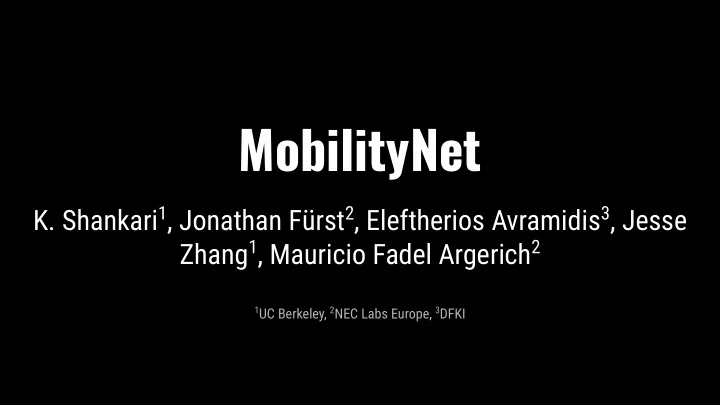

MobilityNet K. Shankari 1 , Jonathan Fürst 2 , Eleftherios Avramidis 3 , Jesse Zhang 1 , Mauricio Fadel Argerich 2 1 UC Berkeley, 2 NEC Labs Europe, 3 DFKI
Outline » Motivation and relation to climate change » Dearth of good quality datasets for mobility » MobilityNet: privacy preserving, cross platform, ground truthed ⋄ 1080 hours of multimodal, diverse data ⋄ 16 sets of travel contexts (e-scooter, bike, walk, etc)
Motivation
Transportation emissions 📉 25%->28% 29% Photo by Arthur Ogleznev from Pexels 7.0 (1990) (2015) Contribution Increasing trend GtCO2eq worldwide
Travel behavior is critical Greenhouse Gas (GHG) reduction strategies: » Behavior: Avoiding journeys (land-use, tech) » Behavior: Modal shift » Engineering: Lowering energy intensity (fuel efficiency) » Engineering: Reducing fuel intensity (alternative fuels) New Delhi, near the Yamuna river, in Mar 2018 and Apr 2020, In India, life under coronavirus brings blue skies and clean air, Washington Post
Public policy stakes example budget 6 meetings ~ $292 50 - 300 Billion Understanding data attendees each accuracy is key! Over 4 lawsuits 30 years ( e.g. census ) Karen Trapenberg Frick (2016) Citizen activism, conservative views & mega planning in a digital era, Planning Theory & Practice, 17:1, 93-118, DOI: 10.1080/14649357.2015.1125520
Limitations of existing datasets
Power vs. accuracy » Geolife dataset 182 users, 3 years ⋄ GPS data from dedicated devices ⋄ 2 sec interval ⋄ » SHL challenge Kitchen sink data collection ⋄ 8 sensors, high frequency ⋄ Only single user 4 month subset ⋄ released Battery icons shape perceptions of time and space and define user identities. City University London. https://phys.org/news/2019-09-battery-icons-perceptions-space-user.html
Privacy » Location data is inherently privacy sensitive Redacting user name and email is not enough ⋄ Fuzzing ends is not enough ⋄ Home + work combination at cell tower granularity ⋄ unique for more than 50% of users* ⋄ » Very little public data Opportunity Activity Recognition Challenge (no GPS) ⋄ US-Transportation Mode Dataset (no GPS) ⋄ Multiple mode inference papers (no dataset ⋄ published) * Montjoye, Yves-Alexandre de, César A. Hidalgo, Michel Verleysen, and Vincent D. Blondel. 2013. “Unique in the Crowd: The Privacy Bounds of Human Mobility.” Scientific Reports 3 (March). https://doi.org/10.1038/srep01376.
Ground truth » Primary focus on travel mode » Prompted recall (PR): show list of trips for labeling But mode depends on correct ⋄ segmentation! PR unreliable as ground truth* ⋄ Certainly wrong 9% ⋄ Probably wrong additional 10% ⋄ » No spatio-temporal ground truth * Peter R. Stopher, Li Shen, Wen Liu, and Asif Ahmed. The Challenge of Obtaining Ground Truth for GPS Processing. Transportation Research Procedia , 11:206–217, 2015. ISSN 23521465. doi: 10.1016/j.trpro.2015.12.018
MobilityNet
Concepts » Artificial trips Uses: Pre-defined spec with trajectories and modes ⋄ Solves: Privacy and spatial ground truth ⋄ » Control phones Uses: Multiple phones with auto-configured app ⋄ accuracy and power controls ⋄ Solves: Power/accuracy tradeoff, temporal ground truth ⋄ » Repeated travel Uses: Pre-defined spec with travel time and dwell time ⋄ Solves: Context sensitive variation from sensing APIs ⋄
Sample spec
Data characteristics » Trip characteristics ~3x dwell time vs mean travel time ⋄ Travel between public locations to preserve privacy ⋄ » Transfer Between Modes Detecting mode transfer is hard ⋄ MobilityNet contains many different mode transitions ⋄ » Large and multimodal Over 1080 hours across 16 different travel contexts! ⋄ Similar modes done in different contexts ⋄
Data sources » Primarily from Virtual Sensors Closed source APIs provided by phone OS ⋄ » Fused Location GPS/WiFi/Cellular (ts, lat lon, accuracy, speed) ⋄ » Motion Activity Accelerometer/gyroscope/barometer (ts, confidence, type) ⋄ » Trip Transition Events Virtual and custom platform duty cycling events (exit geofence, ⋄ stop moving, tracking stop) » Battery
Mobility Diary » Sensed data → Mobility Diary Raw data -> trip/section trajectories w/ transport modes ⋄ » Construction Trip Segmentation ⋄ Data will have gaps ⋄ Section Segmentation ⋄ Travel by one mode ⋄ Trajectory Filtering ⋄ Erroneous data can be common ⋄ Mode Inference ⋄ Hard to distinguish some modes from others ⋄
Metrics » Trip and section segmentation Difference in count ⋄ Difference in start and end timestamps ⋄ » Trajectory outlier detection Spatial: Δ (point, ground truth trajectory) ⋄ Spatio-temporal: Δ (point, reference ⋄ trajectory) » Mode classification Segmentation dependency ↔ % matching ⋄ Force segmentation ↔ F1 score? ⋄ » Battery drain
Baseline results
Conclusion » Accurate travel behavior Critical for long-term mitigation of transportation GHG ⋄ » Lack of public datasets » MobilityNet: 1040 hours of cross-platform data http://mobility-net.org/ / https://github.com/MobilityNet/ ⋄ » Call to action Classic challenges on the public dataset ⋄ Data collection from other locations for a larger public dataset ⋄ Hybrid challenges, run winning algorithms on large private data ⋄
Recommend
More recommend